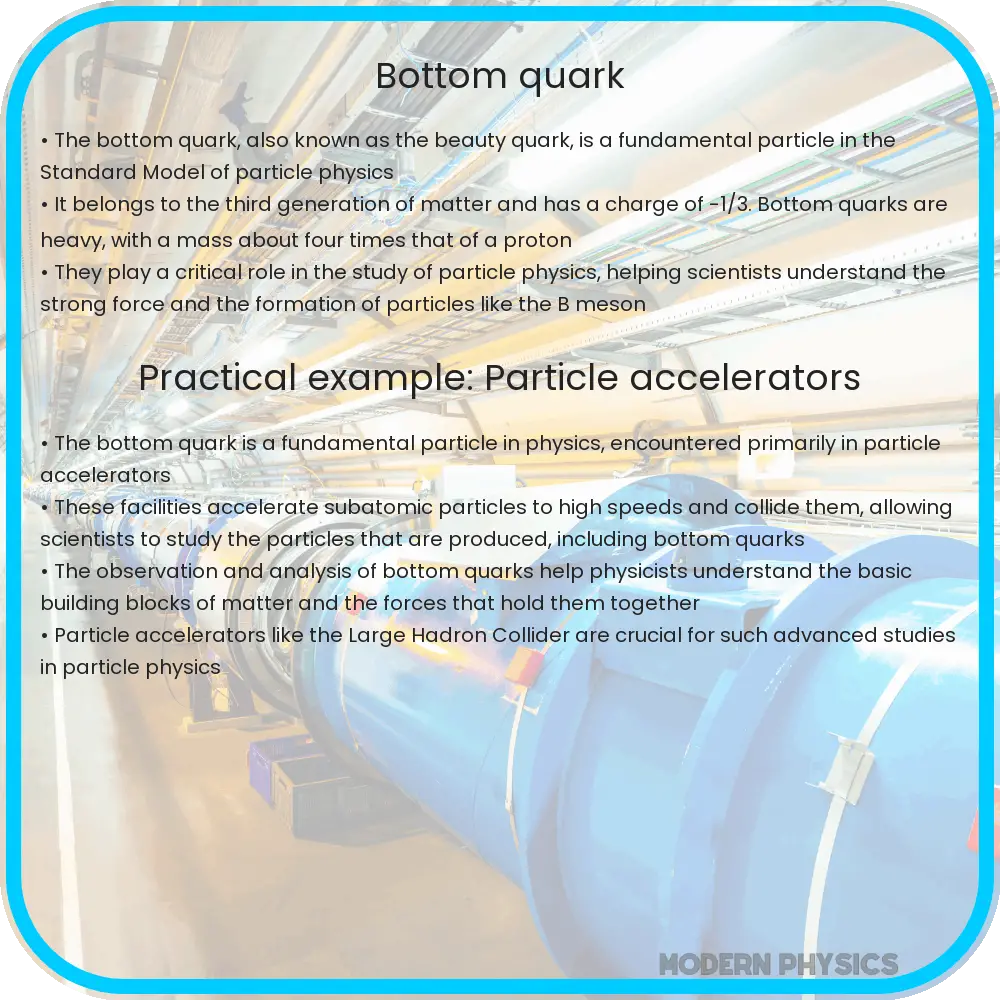Explore the role of the bottom quark in Quantum Chromodynamics and particle physics, uncovering its significance in the universe’s fundamental forces.

Understanding the Bottom Quark in Quantum Chromodynamics
Quantum Chromodynamics (QCD) is a fundamental theory in particle physics that describes the strong interaction, one of the four known fundamental forces, governing the behavior of quarks and gluons. Within this framework, the bottom quark, also known as the beauty quark, plays a significant role in understanding the complex nature of subatomic particles.
The Bottom Quark: A Key Player in the Subatomic World
The bottom quark is a third-generation quark, a type of elementary particle and a fundamental constituent of matter. Discovered in 1977 at the Fermilab, the bottom quark has a mass significantly greater than that of up and down quarks, the first-generation quarks making up protons and neutrons. This high mass makes the bottom quark an intriguing subject for studying QCD and the interactions that govern particles at the most fundamental level.
Quantum Chromodynamics: The Theory of Strong Interaction
QCD is a part of the Standard Model of particle physics, which provides a theoretical framework describing how the fundamental building blocks of the universe interact. It specifically addresses the interactions between quarks and gluons, the latter being the force-carrier particles of the strong force. QCD is characterized by the concepts of color charge and confinement, which are unique to the theory of strong interactions.
Color Charge and Confinement in QCD
Unlike electric charge in electromagnetism, QCD introduces the concept of color charge. Quarks come in three “colors” – red, green, and blue – and they interact via gluons, which carry the color force. The principle of confinement in QCD states that quarks are never found in isolation; they are always confined within larger particles like protons, neutrons, or mesons. This phenomenon is particularly significant in the study of the bottom quark, whose interactions and decays provide insights into the confinement mechanism and the overall behavior of the strong force.
One of the most fascinating aspects of the bottom quark is its involvement in particle decays and the creation of new particles. Due to its high mass, the bottom quark can decay into a variety of lighter particles, a process governed by the weak nuclear force. These decay pathways offer a rich field for research, as they provide opportunities to study aspects like CP violation and the imbalance between matter and antimatter in the universe.
In conclusion, the bottom quark serves as a critical element in the study of Quantum Chromodynamics. Its unique properties, including its mass and interaction patterns, contribute significantly to our understanding of the strong force and the fundamental structure of matter. As research progresses, the insights gained from studying the bottom quark continue to shed light on the deepest mysteries of particle physics and the workings of the universe.
Decay Patterns and the Role of the Bottom Quark in Particle Physics
The bottom quark is known for its intriguing decay patterns, which play a crucial role in particle physics research. These decays are primarily mediated by the weak force, leading to the production of various particles. Understanding these decay processes is vital for testing the Standard Model’s predictions and exploring beyond it. The rare decay processes involving bottom quarks are of particular interest, as they might hint at new physics or interactions not accounted for in the current model.
CP Violation and the Matter-Antimatter Asymmetry
A key area of interest in studying the bottom quark is CP violation, a phenomenon that could explain the observed matter-antimatter asymmetry in the universe. CP violation refers to the difference in behavior between a particle and its antiparticle and is closely studied in systems involving bottom quarks. Experiments in particle accelerators, such as the Large Hadron Collider (LHC), actively investigate these violations by analyzing the decay of B mesons, particles containing a bottom quark.
Experimental Studies and Technological Advances
Advancements in particle accelerator technology have significantly enhanced our ability to study bottom quarks. Facilities like the LHC allow scientists to create and study particles containing bottom quarks under extreme conditions. This research not only tests the predictions of Quantum Chromodynamics but also explores possible new physics beyond the Standard Model.
Challenges and Future Directions
Despite significant progress, challenges remain in fully understanding the bottom quark and its role in QCD. Theoretical predictions are often complex and require highly sophisticated computational techniques. Future experimental and theoretical advances are expected to further unravel the mysteries surrounding the bottom quark, providing deeper insights into the fundamental forces and particles that constitute our universe.
Conclusion
In summary, the bottom quark is a pivotal element in the realm of particle physics, particularly within the study of Quantum Chromodynamics. Its unique characteristics, such as its mass and role in CP violation, make it a valuable tool for probing the fundamental forces that govern our universe. The ongoing research involving the bottom quark not only tests the limits of the Standard Model but also paves the way for discovering new physics. As we continue to delve deeper into the subatomic world, the bottom quark remains a key subject in our quest to understand the universe’s most fundamental aspects.
